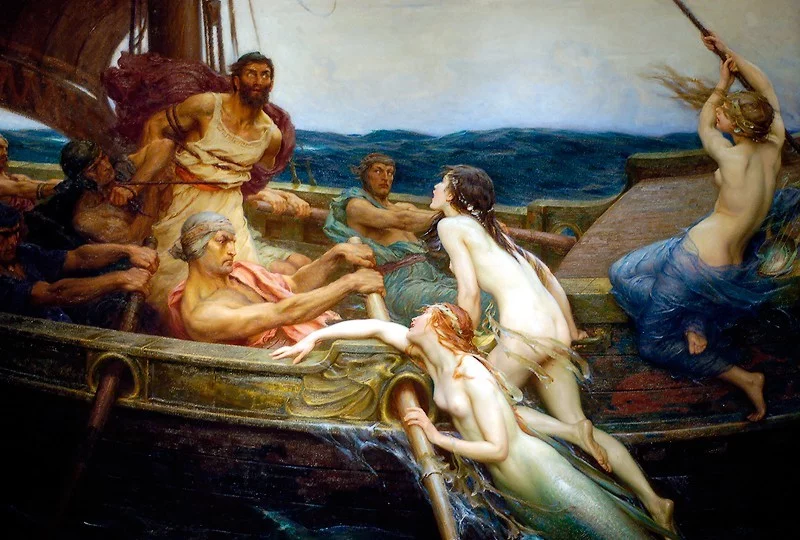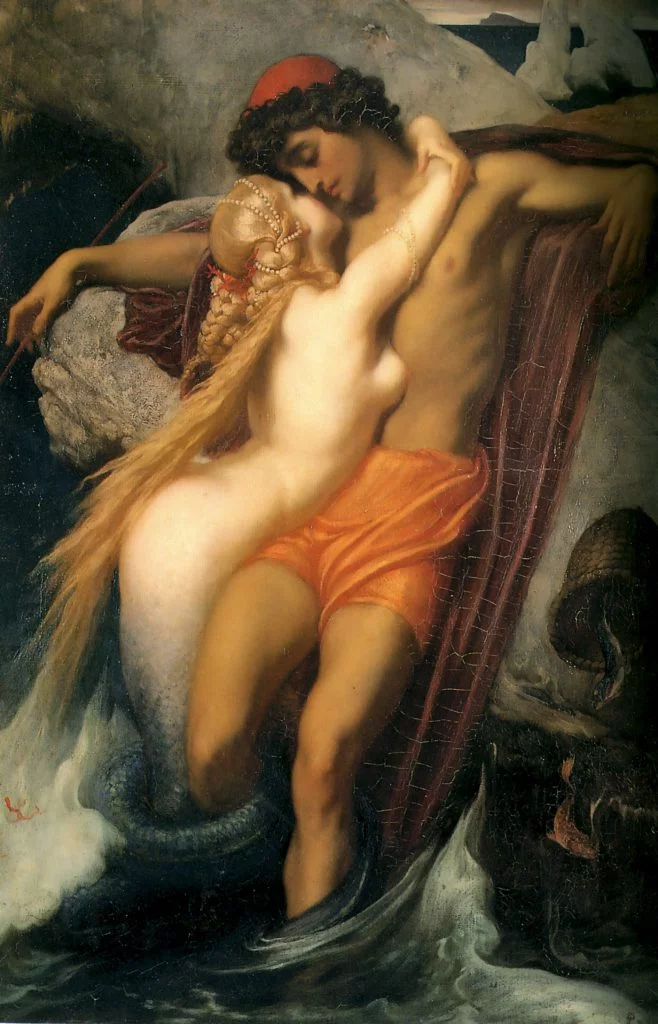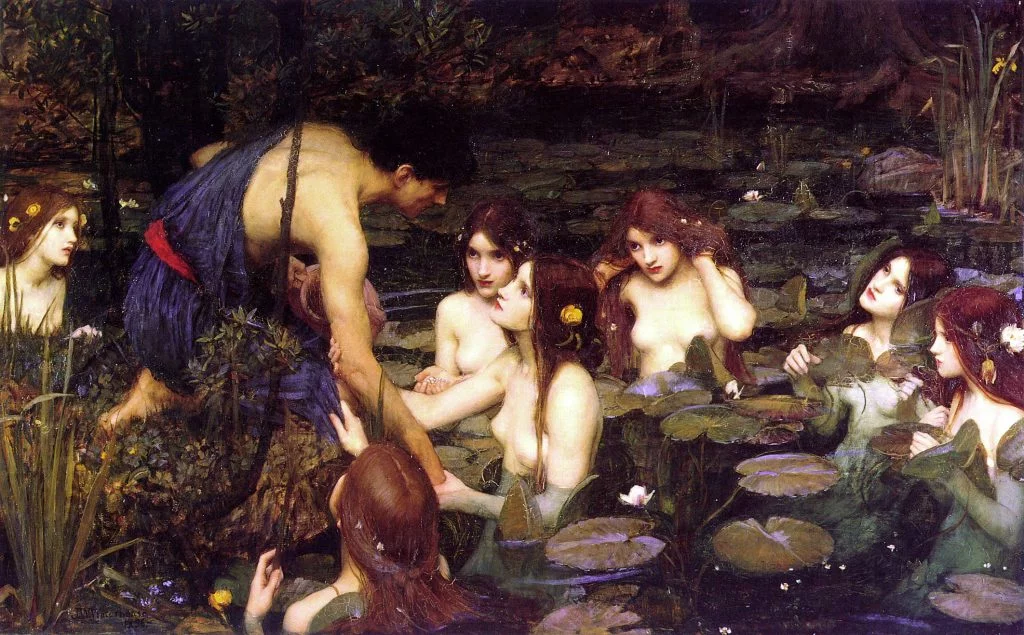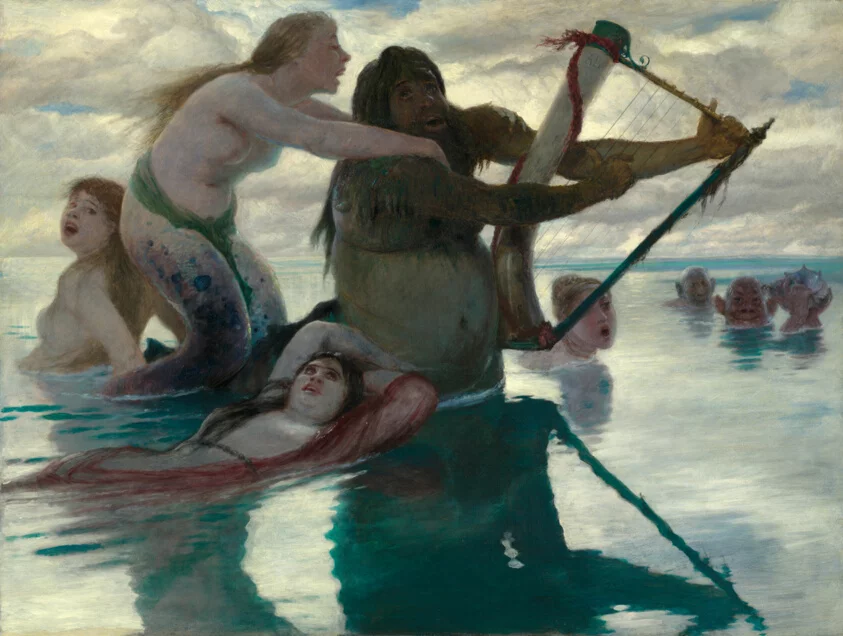Original link: https://shyrz.me/cyberclip-32-siren-song/


Issue 32 of Issue 23 04 08
It rains heavily during the Ching Ming Festival, hello everyone!
This issue’s selection “Recommendation Algorithm is a Necessary Evil” starts with the cases around us, and from different perspectives of users and platforms, analyzes how the recommendation algorithm has come to today, why it is unrealistic to completely ban it, and what attitude we should take The selection “Song of the Siren: The Art History of the Mermaid” takes readers to appreciate the mermaid as a common artistic image in the world, its image changes from ancient times to the present and the creator’s appeal it conveys.
Hope to be enlightened.

Save time, save money!

ClickUp →
One tool for everything – ClickUp provides everything you need in one platform: task management, file management, whiteboard mapping, dashboards, object tracking… and more! Switch to ClickUp today and explore our 100% customizable features!
(Using the link above to register an account helps me run better, and I receive a small sponsorship for every valid registered user)

Recommendation algorithms are a necessary evil
→ Original link : Recommendation Algorithms Are a Necessary Evil (Sort Of) —— Evan Armstrong / Every.to / 2023-03-09
Artificial intelligence is about to reshape our information ecosystem, and we should be ready
 Prompt: A cyberpunk engine using words as fuel, hd, digital art
Prompt: A cyberpunk engine using words as fuel, hd, digital art
Meghan was brought into the arms of the merciful Lord Jesus Christ through the power of YouTube. She initially focused on mom bloggers because she thought they had a “very positive energy”. Then she found out that they frequented the same Target, drank Diet Coke at the same drive-in, both dyed their bleach-blond hair, and went to the same church—which meant they were both from Utah.
She investigated their personal lives for a video series called ” I’m a Mormon .” She symbolically jumped into the deepest part of the baptismal pool and watched hours of YouTube sermons. Eventually, she asked for a copy of the Book of Mormon to be delivered to her home. I know, because I’m that pimple-ridden 20-year-old missionary YouTube sent to deliver books. Not long after, she was baptized (not figuratively) in the baptismal font and joined The Church of Jesus Christ of Latter-day Saints (LDS). On that day, she said she felt “a long-lost hope and freedom”.
Jack escaped from the same group via YouTube. He had recently returned from a mission in a distant country and was watching the same “I’m a Mormon” video. Then the system suggested a new series: ” I’m an ex-Mormon “. Jack was drawn into the video—consuming dozens of hours. From there, Google guided him through various blogs where people questioned the principles of faith he had just spent two years preaching. After several years of questioning and doubt, he left The Church of Jesus Christ of Latter-day Saints. I should know because Jack is my friend. When I asked him how he felt after leaving, he replied: “Long-lost hope and freedom”.
Note: In order to protect privacy, both of the above are pseudonyms.
You may or may not like religion, but it doesn’t matter. The important thing is: Are the AI’s recommendations good ? For individuals, the emotional consequences are the same. As far as I know, neither regrets the choices they made. And without YouTube’s recommendation engine presenting the right video at the right time, neither will make the difference.
The challenge is that “good” depends on the stakeholders . If you’re a devout Mormon, Jack’s choices are wrong and could destroy his soul. If you’re a staunch atheist, Megan is a fool, tricked into a cult. In either case, YouTube sees both outcomes as good because both watched dozens of hours of ad-supported video before making this decision. Other stakeholders—such as society at large, content producers, governments, or advertisers—may have different views on the relative benefits of YouTube’s AI transformation.
To complicate matters further, just how much of a benefit YouTube will bring is up for debate. Ask yourself: What percentage of the actions of these two people can be attributed to the information they were given, rather than their own free will? How much do you believe in individual agency?
This is not a purely philosophical debate. Every day, YouTube users consume more than 1 billion hours of video, over 70% of which is algorithmically served. It’s the second most visited website in the world, and at the heart of its success is its recommendation engine.
Recommendation engines, sometimes called recommendation algorithms, have been blamed for Trump’s election, Biden’s election, mass shootings, the proliferation of vegan restaurants, and TikTok’s dominance. The technology is responsible for your reading this article. Whether Gmail places this article in your “main” inbox, spam, or social tabs, the destination is determined by some type of recommendation engine. They infiltrate e-commerce sites and travel sites. Wherever there is more information than the eye can scan, algorithms are at work, bringing results to the surface.
AI makes this math even more efficient. The same scientific advances that drive products like ChatGPT or self-driving cars are telling you to check out new trailers for Marvel movies. These algorithms do not operate in isolation. They go head-to-head, vying for attention in the marketplace, fighting formulas for dominance. Last May, I wrote about this phenomenon , arguing that “addiction is becoming a blood price that consumers must pay in order for businesses to win.” In the battlefield of the Internet, the more time you spend, the better.
At the intersection of two concerns, business interests and ethical behavior, the recent AI boom worries me. While we’re all still debating the ethical implications of this technology, algorithms keep getting better . These services are increasingly addictive, and there isn’t much an individual can do about it. Tech companies often defend recommendation engines, arguing that when they’re deployed, usage time and customer reviews increase, proving the algorithms are “good.” It’s a circular argument – of course these things go up when customers have access to them, which is what they’re designed to do.
Everyone seems to have an opinion about the technology. Some see algorithms as scary and cause harm, while others see them as morally neutral and even help meet people’s needs. However, in my opinion, the debate is too black and white and too simplistic. Instead, it would be more productive to examine how algorithms affect our decision-making and culture by considering 3 rules that are often overlooked by one or both parties.
- Tech companies need to acknowledge that algorithms are highly editorial, meaning they have the ability to shape opinion and opinion.
- Critics must recognize that design sets the boundaries of influence.
- Monetization sets the boundaries for what incentivizes companies to do with these algorithms.
By examining these overlooked factors, we can discuss in more nuance the role of AI amplification in society.
Think of these rules like the physics in a basketball game — gravity doesn’t determine who wins the game, but it does determine whether the ball makes it to the hoop. My 3 rules don’t determine which system is “good”, but they do allow us to understand how that goodness comes about.
Now is the time to figure this out. Society stands at the center of the AI cage race. On the bottom left, a very powerful AI recommendation engine, and on the right, new generative AI tools that exponentially increase the amount of content to filter. If we fail to do that, the past few years of misinformation, election meddling, and fake panic will look strange by comparison.
edit algorithm
As we discussed earlier, when it comes to recommendation engines, there is no universal “good” because you have to balance stakeholder priorities. Editorial algorithms are one manifestation of this phenomenon—the creators of a product decide which values they want to protect or remove in their apps by choosing the types of content and topics users will see. Technology is not created in a moral vacuum. This is a personal view imposed on the world. To see it in practice, we go back to YouTube.
When the service was in its infancy, it had two simultaneous methods of recommending features. The first is a delightful mock-up run by a team called Cool Hunters, whose job it is to scour the site for good videos and recommend them to the front page. This is combined with a simple algorithm that recommends related videos based on co-visiting records: for example, if you liked this video, another user also liked a similar video. But even early on, there were editorial choices in algorithm design: An early recommendation experiment in the Cars and Vehicles category, for example, simply showed fetish videos of women stomping on the gas pedal of a luxury car. The cool hunter in charge of the car chose to see it as a “bad” video. While a bunch of car-loving womanizers may disagree with the decision, others may be pleased. During the same period, another adjustment of the system accidentally made the relevant part basically full of “boobs and ass”.
For YouTube’s first six years, recommendations were largely focused on optimizing videos with high click-through rates. The results are predictable – short videos with catchy titles work well. However, in 2012, YouTube switched its recommendation engine from primarily rewarding clicks to rewarding watch time. Now, instead of rewarding the videos with the highest click-through rate, the system rewards creators who have produced long-form videos with high completion rates. This shift has destroyed all the creators who built their editorial brand with the aim of being short and crisp. The change resulted in a 25% drop in YouTube’s initial revenue.
By 2017, the platform used an AI technique called reinforcement learning to recommend videos to viewers. In that year alone, the company made more than 300 tweaks to the system to get the recommendations just right. The theory is that the better the video recommendations, the more time people will spend on YouTube because they will be drawn back. It worked. 70% of YouTube views in 2017 came from suggested videos, with overall views up 1%.
However, editorial choices were made even by so-called neutral AIs. At one point, YouTube decided that too many videos it deemed “disgusting” were being shown on the homepage. To solve the problem, the company tweaked its algorithm to use a computer model called a “junk video classifier.” Even the program’s name is a value statement.
In every decision, in every algorithm, Google’s ethical views are fed into the code that determines which videos get exposed. Measuring user engagement as a way of determining video quality and then maximizing it is an editorial choice with ethical consequences. Every recommendation given to a user is a gentle form of persuasion, a way of instilling certain values. The lack of transparency about the values encoded in these recommender systems hampers our ability to understand what’s going on—and the only reason we know of it is because of years of dedicated journalism . How the company operates has never been transparent.
I like what Instagram co-founder Kevin Systrom said when discussing Artifact, his recently launched news recommendation app. “Building algorithms is very editorial. Because what you choose to train your algorithm with — the objective function, the data you put in, the data you include, the data you don’t include — is all in the editorial judgment,” he said.
When we judge whether an AI system is good or not, we must recognize the value system imposed on it by its creator.
design decides destiny
Just as the values determine the performance of the algorithm, the design of the product where the engine is located also determines the performance of the algorithm. In order to understand how good or bad AI recommendations are, you need to understand which data inputs and user signals your app prioritizes.
No company’s recommendation engine has been subject to public criticism longer than Facebook. It feels like Mark Zuckerberg is being called to testify before Congress every other week. No matter how much money is invested, it is impossible for a recommendation engine to truly satisfy everyone. An internal Facebook memo written in 2019 titled ” What is Collateral Damage? ” offers some clues as to why the platform has never been able to balance broader social good with the need for corporate growth:
“We also have convincing evidence that our core product mechanics, such as virality, recommendation, and user engagement optimization, are a significant reason why these (negative) discourses prevail on the platform.”
“If integrity takes a hands-off approach to these issues, whether for technical (precision) or philosophical reasons, the end result is that Facebook as a whole will be actively, if not consciously, promoting these types of (negative) activities . The mechanics of our platform are not neutral.”
According to the company’s own research, data inputs into how Facebook makes recommendations, such as likes or shares, tend to be biased toward negative content. Facebook’s documents further suggest that the company has followed YouTube’s path. They will notice a problem and make some changes in the hope that the outcome will be good without having to understand the black box of the algorithm. However, both companies operate on a human scale. It’s impossible for them to make any changes without causing major harm.
On the other hand, TikTok’s entire app design is entirely focused on improving its recommendation engine. The format of the short video allows for quick feedback. Videos play automatically, meaning users immediately show how they feel about the recommendation by watching or swiping. By combining this with machine learning tags (this video has puppies, skis, etc.), the algorithm can learn what you like. Eugene Wei calls this “algorithm-friendly design.”
The result is that TikTok has created the most addicting experience I’ve ever had in technology. This is a hit . Over the past few years, it has become one of the few consumer social apps to achieve global success. It’s so powerful that it’s convincing America’s teens to believe they have Tourette’s syndrome . One stakeholder (TikTok shareholders) would be ecstatic. the child’s parents? Not that much.
The result is that TikTok has created the most addicting experience I’ve ever had in technology. This is a TV show . Over the past few years, it has become one of the few consumer social apps to be successful globally. It’s so powerful it’s convincing America’s teens that they have Tourette’s syndrome. One stakeholder (TikTok shareholder) would be ecstatic. the child’s parents? Not that much.
In contrast, Facebook launched its recommendation engine two years after launching its News Feed. Since the incoming signal was less clear, it was difficult for Zuckerberg to understand what was going on, which meant it was harder for the company to fine-tune performance. When we consider whether a system is good, we must look at how the design affects the outcome.
Compare this to Facebook, where the recommendation engine was added two years after the company launched with the invention of the News Feed. With less clear incoming signals, it was difficult for Zuckerberg to understand what was going on, which meant it was harder for the company to fine-tune performance. When we judge whether a system is good or not, we must look at how the design shapes the outcome.
Profits don’t care about your morals
Charlie Munger once said , “Give me incentives and I’ll give you results.” When evaluating a recommendation engine, how a company makes money will affect relative good and bad. There are 3 profit strategies, each with their own tradeoffs and costs:
- The current threat is the advertising model . Companies will deploy AI recommendations to motivate people to scroll, swipe, and watch longer. It’s rare to say, “I’m glad I spent an extra 15 minutes on TikTok today,” but that’s exactly what system optimization is about. The downside is fairly obvious — at its extreme, the ad model can fuel misinformation and outrage . Well-known companies like Meta, Snapchat, Twitter, and Pinterest have all tuned their recommendation engines for this use case.
- The second most common use case for recommendation engines is discrete unit sales . Think about it when you buy a product on Amazon and it asks: “Do you want this too?” This works, but it also increases the average order value and “forces” people to spend more. Again, the benefits of this model are relative. It’s good for Amazon, and it’s good for the small businesses that sell on the platform, but it’s not good for people with compulsive shopping tendencies. Sometimes, you’ll see that these engines don’t make money right away, but instead try to keep people engaged for the opportunity to sell other products later. Platforms that monetize unit sales this way include Airbnb, Etsy, and Walmart.com.
- Finally, there are subscriptions . In this case, recommender systems are designed to provide a lagging product experience, embedded with suspense that makes people pull out their credit cards. Think of Tinder — it deliberately designed the experience to be alluring, horny and frustrating at the same time. As users indulge, they’re asked to subscribe to boost their profile and (supposedly) improve their results. Other companies, other companies like Netflix, Substack, and The New York Times were forced to put up paywalls for their most hookable content, so when you needed the service most, you had to whip out your credit card to keep using it.
Importantly, all of these systems can be understood to lead to “bad” outcomes. You can also make an equally convincing argument that these profit plans are good! Advertising keeps information free, sales don’t burden people with recurring bills, and subscriptions foster long-term consumer/creator relationships. Unfortunately, they’re not as bad as advertised.
To further complicate matters, almost all companies offer some combination of the three methods above. Seriously, the publication has a subscription tier, sells ad space, and offers courses that can be purchased. In none of these respects am I immune to criticism. My interaction with recommendation engines is very little other than the occasional twitter or inbox triage, but I do think about it a lot!
What really matters is that all three ways to make money are competing in the same market – the Internet. Winners in their respective markets compete over which approach is best for their competitive landscape, not what is right for stakeholders. When we try to judge whether system X or Y is relatively good, we must consider which negative and positive behaviors are motivated.
evaluate
Imagine the perfect recommendation engine.
Everyone who uses it will be magically inspired to the limit of their abilities. Suddenly, the world was full of people with toned abs, PhDs, and perpetual smiles. People changed their actions because they got the information they needed, when they needed it. But this is clearly an illusion! It never happens. There is a huge gap between what we say and what we actually do. There is a discrepancy between what people say and what they really want.
I just don’t think it’s possible to get a recommender system that pleases everyone; there are too many stakeholders with directly conflicting needs.
The answer may be that companies should empower users to control the recommendation engines that interact with them. This sounds tempting, but I have concerns. We interact with not one or two of these engines every day, but dozens. They are all around us, paying attention to them all the time. How likely is the user to be able to correctly adjust each of these individually? Really controlling these systems will require technical knowledge about neural networks, weights, and datasets, which 99.99% of consumers don’t understand. Too bad the companies that build these things don’t really understand what’s going on inside them either! Why expect the user to figure it out? Saying that user empowerment solves this problem feels like token empowerment, not real personal freedom.
Another seemingly obvious answer is to ban the use of recommendation engines. However, things are not that simple. Because there is so much data and information on the Internet, we cannot do away with this technology. In order to make the Internet more useful, we must use recommendation engines. A world without recommendation engines would have fewer choices, lower quality information, and less entertaining entertainment.
Frankly, right now I don’t know what the best answer is. The point of this post is to show that this problem does not have a concise solution. To figure this out, we, as technicians, need to study hard and work hard. I hope the 3 frameworks I propose below can be helpful in looking at this topic with a more discerning eye:
- Algorithms are editorial
- design decision result
- Earnings Don’t Care About Your Feelings
Over the next month, I will discuss this topic in detail. This really matters. The Internet gave me careers, introduced me to my wife, and made me empathize with people like Jack and Megan. I hope it thrives, continues to improve, and continues to be one of humanity’s greatest achievements. To preserve and protect it, the builders of the next decade will have to do better.

Song of the Siren: A History of Mermaid Art
→ Original link : Siren Song: History of Mermaids in Art ——Candy Bedworth / DailyArt Magazine / 2023-03-29

Benevolent beautiful creature or deadly assassin? From ancient scrolls to popular culture, from maps to modern literature, there are so many descriptions of this mythical creature. This History 101 column explores how mermaids are portrayed in art.
melancholy mermaid
Often presents as sitting alone, longing for human company, but unable to live on land. These wistful creatures are perhaps the most common in the history of art. Her beauty is alluring, but her mood is lonely. The following famous image was inspired by an 1830 poem by Alfred Tennyson:
Who would be a mermaid fair, singing alone, combing her hair.
Who will be the beautiful mermaid, singing alone, combing her hair.
—Alfred Tennyson, The Mermaid
 John William Waterhouse / The Mermaid / 1900 / Royal Academy, London, UK
John William Waterhouse / The Mermaid / 1900 / Royal Academy, London, UK
sailor mermaid
The Greeks were afraid of the sea monster, thinking that the sea monster would lure sailors to die with their songs. British sailors considered this phenomenon to be a bad omen, bringing death. Other cultures were a little more sympathetic – Chinese sailors believed they could offer immortality, and even wept pearls instead of tears. Japanese fishermen use mermaid souls for protection. The prow statue usually has the image of a mermaid. These carved wooden statues were meant to appease the god of the sea and allow sailors to cross the ocean safely. In the image below, the relationship between the mermaid and the sailor is unclear, but the hug looks romantic. Is this an affectionate farewell? Did she just save him? Artist Howard Pyle died before finishing the work, so we’ll never know for sure.
 Howard Pyle / The Mermaid / 1910 / Norman Rockwell Museum / Stockbridge / Massachusetts / USA
Howard Pyle / The Mermaid / 1910 / Norman Rockwell Museum / Stockbridge / Massachusetts / USA
ancient mermaid
Early civilizations were established near bodies of water, so it’s no surprise that people both loved and feared marine life. We think the first mermaid creature to appear in mythology was a Babylonian god named Enki or Ea 7,000 years ago, but it was a male. We trace the first mermaid back to 1000 BC, when the goddess Atargatis dived into a lake in Syria and transformed into a fish-like creature. She is featured on ancient coins and in temples.
 Statue of Atargatis / AD 100 / Jordan Archaeological Museum / Amman / Jordan / Image credit: Dennis Jarvis via Wikimedia Commons (CC BY-SA 2.0)
Statue of Atargatis / AD 100 / Jordan Archaeological Museum / Amman / Jordan / Image credit: Dennis Jarvis via Wikimedia Commons (CC BY-SA 2.0)
The Mappers and the Mermaids
Early mapmakers would include sea monsters in their illustrations to denote dangerous seas or areas of frequent severe weather. This was a very intuitive clue to a possibly illiterate sailor. Early cartographers (map makers) were artists and explorers, and there are many beautiful examples including mermaids.
 Map of Diego Gutiérrez / 1562 / Rosenwald Collection, Library of Congress, Washington DC, USA / detail
Map of Diego Gutiérrez / 1562 / Rosenwald Collection, Library of Congress, Washington DC, USA / detail
religious mermaid
Of course, the church also dabbles in this topic. They see mermen as lustful creatures, vain sexual predators, the worst kind of woman. The scroll Bestiaire Divin, written in 1210 by Guillaume, le Clerc de Normandie, tells of the sins of mermaids, calling them whores and whores. Flowing hair, bare breasts, refusal to submit to human domination – these maidens are strictly pagan. However, they continued to appear in various churches afterwards.
 Medieval Engraving / Cheriton Episcopal Church / England / 16th Century / Escape to England
Medieval Engraving / Cheriton Episcopal Church / England / 16th Century / Escape to England
african mermaid
Mami Wata means mother of water and she is famous all over Africa. Myths vary, and in some myths, her gender may be fluid. However, the unifying feature of all these myths is that Mami Vata is a benevolent creature who provides healing and wisdom and warns against natural disasters.
 Mamie Watta / 1950s / Minneapolis Institute of Arts / Minneapolis / USA
Mamie Watta / 1950s / Minneapolis Institute of Arts / Minneapolis / USA
scam mermaid
In 1822, showman PT Barnum exhibited his Fijian Mermaid. It generated huge interest, but unfortunately, it later turned out to be a very clever hoax. Tourists hoping to see the Mermaid find instead a mummy of half a fish sewn onto the body of a half monkey. Similar fake mermaids can be found in museums around the world.
 Buxton Mermaid / 18th Century / Buxton Museum and Art Gallery / Buxton / England
Buxton Mermaid / 18th Century / Buxton Museum and Art Gallery / Buxton / England
greek mermaid
A famous Greek story involves Alexander the Great’s sister. Thessalonike became a mermaid after her death in 295 BC, and she lived in the Aegean Sea. Only when her brother is said to be alive and ruling the world will she allow the ship to pass safely. Perhaps the most famous story was written by Homer, in which the siren in the Odyssey tries to lure the hero Odysseus (also known as Ulysses) to drown.
 Herbert James Draper / Ulysses and the Sirens / 1909 / Ferrence Gallery / Kingston upon Hull / UK
Herbert James Draper / Ulysses and the Sirens / 1909 / Ferrence Gallery / Kingston upon Hull / UK
medieval mermaid
The Melusine appears in medieval stories—sometimes she has a snake-like body, sometimes she has wings. Her father is human and her mother is a fairy, and her story does not have a happy ending. As in most medieval stories, women must stumble and fail in order to be educated. Mermaids also make an accidental appearance in copies of the Bible – in the image below, they frolick beneath Noah’s Ark.
 Anton Koberges / German Bible / Woodcut of Noah’s Ark / 1483 / Library of Congress / Washington DC / USA
Anton Koberges / German Bible / Woodcut of Noah’s Ark / 1483 / Library of Congress / Washington DC / USA
Mermaids of Southeast Asia
Suvannamaccha (goldfish) is a character depicted in frescoes and paintings, and also appears in the epic Ramayana. Suvannamaccha meets one of the heroes of the story, Hanuman, who is trying to build a stone bridge across the sea. She tries to stop him, but eventually falls in love with him and helps him with his mission.
 Ramakien Mural / 1783 / Bangkok, Thailand / Photo credit: Dharma via Wikimedia Commons (CC BY-SA 2.0)
Ramakien Mural / 1783 / Bangkok, Thailand / Photo credit: Dharma via Wikimedia Commons (CC BY-SA 2.0)
seductive mermaid
The piece shown below was inspired by a poem by Goethe about a mermaid rising out of the water to complain to the fisherman that he was luring her children (fish) to die in his net. The beauty of the mermaid lures the fisherman into the water and makes him forget himself. Note the cross shape of the fisherman’s body, and the mermaid tail coiled around his leg. With her seductively destructive powers, the mermaid lures the handsome, worldly Christ to his death.
 Frederick Leighton / The Fisherman and Salem / 1856 / Bristol City Museum and Art Gallery, UK
Frederick Leighton / The Fisherman and Salem / 1856 / Bristol City Museum and Art Gallery, UK
pre raphaelite mermaid
The Victorian painter John William Waterhouse was a favorite of the British public. His romantic, childish female nudes are perfect examples of the male gaze . There was an uproar when Manchester Art Gallery removed Hylas and the Nymphs from its exhibition as part of artist Sonia Boyce’s project focusing on issues of race, gender and sexuality. The gallery said the (temporary) removal was part of a discussion surrounding the representation of women in art history, particularly the sexual objectification of women’s bodies. Media and art historians, almost exclusively male, disagree.
 John William Waterhouse / Silas and the Nymphs / 1896 / Manchester Art Gallery / Manchester / UK
John William Waterhouse / Silas and the Nymphs / 1896 / Manchester Art Gallery / Manchester / UK
Post-Freudian mermaids
Sigmund Freud , the founder of psychoanalysis, had firm ideas about our hidden urges, and mermaids seem to be the embodiment of subconscious desires. Freud speaks of men’s castration fears, while mermaids perfectly illustrate the rapacious, carnivorous woman. This is in painful contrast to the man’s desire to return to the safety of his aquatic womb. Edward Munch painted more than one mermaid. In the painting below, she is in the process of metamorphosis, and we can really feel the mixture of desire and anxiety.
 Edvard Munch / The Mermaid / 1896 / Philadelphia Museum of Art / Philadelphia / Pennsylvania / USA
Edvard Munch / The Mermaid / 1896 / Philadelphia Museum of Art / Philadelphia / Pennsylvania / USA
surreal mermaid
René Magritte shows us a mermaid who has abandoned her marine environment, but in a surreal twist, she is an inverted mermaid with a fish-like head and human legs. In Magritte’s subversive work, although the picture has a sense of sadness – the mermaid seems to be stranded, unable to live neither in air nor in water.
 René Magritte / Collective Creation / 1934 / Private Collection / WikiArt
René Magritte / Collective Creation / 1934 / Private Collection / WikiArt
mermaids in literature
It’s no surprise that mermaids pop up in literature and the visual arts. Hans Christian Andersen’s The Little Mermaid, written in 1836, is probably best known. Respected British illustrator Arthur Rackham created some gorgeous images that are still highly collectable today. In contemporary fiction, two recent novels explore deep cultural questions surrounding power, sexuality, and women’s place in society. Highly recommend The Mermaid of the Black Conch by Monique Roffey and The Mermaid and Mrs Hancock by Imogen Hermes Gower.
 Arthur Rackham / Rheingold and the Valkyries / 1910 / Wikimedia Commons (Public Domain)
Arthur Rackham / Rheingold and the Valkyries / 1910 / Wikimedia Commons (Public Domain)
mermaids in pop culture
When science and reason demanded that we abandon mythical creatures, we still cling to mermaids. In the 1970s, pop art fan Roy Lichtenstein added a very modern mermaid to Miami’s waterfront. In 1984, Tom Hanks fell in love with blonde Darryl Hannah in the fantasy blockbuster Splash , and in 1989, Disney Studios made a red-haired, blue-eyed Ariel. In 2023, Disney plans to revisit the story with a black mermaid. Racists across America have been mocking Disney ever since.
 Roy Lichtenstein / The Mermaid / 1979 / Miami Beach / Department of Art for Public Places / Miami / Florida / USA
Roy Lichtenstein / The Mermaid / 1979 / Miami Beach / Department of Art for Public Places / Miami / Florida / USA
contemporary mermaid
As mermaids have become more “cute” in modern society, they have fallen out of favor in the fine art world. But we had to include the work of Canute Caliste , a naive painter from a small Caribbean island near Grenada. He had visions of mermaids at the age of nine that haunted his work until his death in 2005.
 Canute Callister / The Mermaid / Photo credit: NickCT via Wikimedia Commons (CC BY-SA 4.0)
Canute Callister / The Mermaid / Photo credit: NickCT via Wikimedia Commons (CC BY-SA 4.0)
Connie Imboden photographs the human body in water in a very different artistic style, using the natural effect of light on the human body underwater to produce captivating images.
gay mermaid
Gay culture , especially the transgender community, has embraced the symbol of the mermaid, and her transformative “otherness.” Their half-fish, half-human dichotomy echoes that of the LGBTQI+ community. Mermaids break the heterosexual rules of traditional society and celebrate gender as a fluid concept. Mermaids UK , a network of transgender youth, has teamed up with sculptor Eve Shepherd and the Royal Museums Greenwich to produce Man of the Sea.
 Eve Shepard / Sea People / 2019 / National Maritime Museum / London / UK
Eve Shepard / Sea People / 2019 / National Maritime Museum / London / UK
any other name
Across the globe, the mermaid-like sea creature has countless names and incarnations. Almost all stories involve an aquatic creature with a human-like head and upper body but with a fish tail: Naiads or Nereids, Sea Nymphs, Lamia, Rusalkas, Aycayia, Iara, Ningyo, Nixes, Merrows, Selkies , Kuliti.
symbol
Is it an important symbol of female freedom and fertility or the chaos of the ocean and the brutality of a free female revenge? The mermaid is all of these and more. Some say mermaids are alien creatures, others that they are the ghosts of drowned women, and others that they lure humans into the water to eat their flesh. Some say they’re just manatees or dugongs seeing through lonely, sleep-deprived eyes. If they were of human origin, did the mermaids escape to the free ocean or were they banished there?
 Arnold Böcklin / “In the Sea” / 1883 / Art Institute of Chicago / Chicago / Illinois / USA
Arnold Böcklin / “In the Sea” / 1883 / Art Institute of Chicago / Chicago / Illinois / USA
our obsession
Beautiful and captivating, wild and untamed, mermaids are the perfect representation of humanity’s relationship with the sea. It offers adventure and freedom, but it is unpredictable and unfathomable. Our early ancestors crawled up from the sea, our own lives began in wombs in the water, and it seems our fascination with these wondrous aquatic creatures will never be satisfied.
 Gustav Klimt / The Mermaid / 1899 / Albertina / Vienna / Austria
Gustav Klimt / The Mermaid / 1899 / Albertina / Vienna / Austria  Frans Francken / Allegory of the Ship of Nations / 16th century / National Maritime Museum, London, UK
Frans Francken / Allegory of the Ship of Nations / 16th century / National Maritime Museum, London, UK 
-
 Society: honey, I sold the baby
Society: honey, I sold the baby
We have laws protecting children from factory labor. Why not protect them from parents who exploit them for online profit? -
 Efficiency: How (and not to) read more
Efficiency: How (and not to) read more
The purpose of this article is to dare to be the first to pour cold water on “how to read less”. However, the premise is that we first polish the tools so that we have the qualifications to “do not read this” and “do not read that”. -
 Art: Illustrator: Alphonse Mucha – The Reluctant Poster Kid of Art Nouveau
Art: Illustrator: Alphonse Mucha – The Reluctant Poster Kid of Art Nouveau
At designstripe, we value Mucha’s belief in the beauty of everyday objects, as well as his egalitarian view of what constitutes art. He is the artist who elevated the poster to art, and by integrating illustration, message and design, he established the foundations of modern artistic communication.  Tech: Welcome to the age of fake six-pack abs
Tech: Welcome to the age of fake six-pack abs
Rigged, visible abs were once only found in genetically-advantaged fitness fanatics. But now, more and more men pay high fees to ask doctors to complete this “sculpture” for them. Tech: There’s nothing unnatural about computers
Tech: There’s nothing unnatural about computers
James Breed’s Way of Being wants us to re-examine the wisdom of nature

 If you like CyberClip and want to help me run it better:
If you like CyberClip and want to help me run it better:
- Forward to a friend or social network
- See the Advertise page Contact me to advertise
- Give me appreciation in Aifafa or WeChat, welcome to note title, email
- Click below with
 Marked promotion links, I can receive a meager sponsorship for every valid click of yours
Marked promotion links, I can receive a meager sponsorship for every valid click of yours - In case you have a need, pass the following with
 Marked promotion link registration fee, I will be able to get a certain percentage (marked) rebate from your payment. Please do what you can and consume rationally.
Marked promotion link registration fee, I will be able to get a certain percentage (marked) rebate from your payment. Please do what you can and consume rationally.
 Thank your for your support!
Thank your for your support!

 ShutterStock – Unique Collection of Royalty-Free Stock Photos, Videos, and Music [Payout Rate: 15%] Looking for high-quality, royalty-free stock photos and videos? Just take a look at Shutterstock. With Shutterstock’s massive database of over 350 million assets, there’s something for every creative project.
ShutterStock – Unique Collection of Royalty-Free Stock Photos, Videos, and Music [Payout Rate: 15%] Looking for high-quality, royalty-free stock photos and videos? Just take a look at Shutterstock. With Shutterstock’s massive database of over 350 million assets, there’s something for every creative project.  Alts.co – The World’s Largest Alternative Investor Community Alts.co is the world’s largest alternative investor community. We like unique, out-of-the-ordinary things. We have over 50,000 subscribers and getting new subscribers is like cutting butter with a knife.
Alts.co – The World’s Largest Alternative Investor Community Alts.co is the world’s largest alternative investor community. We like unique, out-of-the-ordinary things. We have over 50,000 subscribers and getting new subscribers is like cutting butter with a knife.  Revolut – Sign up and get 3 months of free Revolut Premium service When you shop abroad or send money internationally, banks will charge you fees, but we don’t, that’s why more than 4 million people switch to Revolut.
Revolut – Sign up and get 3 months of free Revolut Premium service When you shop abroad or send money internationally, banks will charge you fees, but we don’t, that’s why more than 4 million people switch to Revolut.
Note: marked with
The link is a click link, and I can receive a meager sponsorship for every valid click of yours; marked with
The link is a promotion link, I will be able to get a certain percentage of rebates from your payment

Was this email forwarded by a friend or seen on a social platform? If you think it’s not bad, welcome to subscribe !
If you are interested in advertising on CyberClip, please see our Advertise page and get in touch with me.
CyberClip is a cyber clipping that selects valuable content on the Internet. Every two weeks, it covers new anecdotes, hot issues, cutting-edge technology and other things about life and the future.
 Thank you for reading, welcome to reply, and praise Shi Qi.
Thank you for reading, welcome to reply, and praise Shi Qi.
 Past content | Discussion group | Personal blog
Past content | Discussion group | Personal blog

This article is transferred from: https://shyrz.me/cyberclip-32-siren-song/
This site is only for collection, and the copyright belongs to the original author.